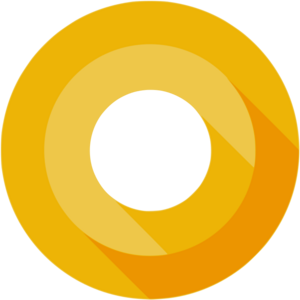Android Oreo facts for kids
| Version of the Android operating system | |
 |
|
Android 8.1 home screen with Pixel Launcher
|
|
| Developer | |
|---|---|
| General availability |
August 21, 2017 (on Android 8.0) December 5, 2017 (on Android 8.1) |
| Final release | 8.1.0_r93 (OSN1.210329.015) / October 4, 2021 |
| Final preview | 8.1.0 (OPP6.171019.012) / November 27, 2017 |
| Repository |
|
| Kernel type | Monolithic (Linux) |
| Preceded by | Android Nougat (7.x) |
| Succeeded by | Android Pie (9.x) |
| Support status | |
|
|
Android Oreo, also known as Android O during its development, is a big update for the Android mobile operating system. It was the eighth main version released by Google.
Google first showed a test version of Android O in March 2017. The public release of Android Oreo happened on August 21, 2017. This version brought many new features. These included better ways to manage notifications and a "picture-in-picture" mode for videos. It also made phones run faster and use less battery.
Android Oreo added support for things like autofill (which helps you fill in forms quickly) and Bluetooth 5. It also introduced Android Go. This is a special version of Android made for phones that are not as powerful. As of August 2025, Android Oreo is the oldest Android version that still works with Google Play Services.
Contents
History of Android Oreo
Android Oreo was secretly called "Oatmeal Cookie" while it was being made. On March 21, 2017, Google let developers try the first test version of Android "O". This early version worked on several Google phones and tablets.
A second test version, which was more stable, came out on May 17, 2017. Then, on June 8, 2017, the third test version was released. This one had the final set of tools for app makers. It also changed how the camera app looked and updated some icons.
On July 24, 2017, the fourth and final test version was released. It had the last bug fixes and improvements. Android "O" was officially launched on August 21, 2017. It was named "Oreo" after the famous sandwich cookie. A special statue for Android Oreo was shown in New York City. This city was where Oreo cookies were first made.
The Sony Xperia XZ1 and Sony Xperia XZ1 Compact were the first phones to come with Android Oreo already installed. A smaller update, Android 8.1, was released in December 2017. It fixed some small issues and made tiny changes to how the phone looked.
What's New in Android Oreo
Android Oreo brought many cool new things to Android phones. These changes made phones easier to use and more powerful.
Better Ways to Use Your Phone
Notifications on Android Oreo can be grouped together. You can also "snooze" them if you want to see them later. This helps keep your notification area neat. There's also a "picture-in-picture" mode. This lets you watch a video in a small window while you do other things on your phone.
The "Settings" app got a new look. It became simpler and easier to find what you need. You can also add your own sounds for ringtones and alarms. The Android 8.1 update showed the battery level for connected Bluetooth devices. It also made the notification area a bit see-through.
How Android Oreo Works
Android Oreo added support for Bluetooth 5. This means faster and more reliable connections to Bluetooth devices. It also improved how apps handle colors, making them look more vibrant. A new tool for autofillers was added. This helps apps fill in your information automatically, like your address or credit card details.
The system also got better at managing apps running in the background. This helps your phone's battery last longer. Apps can now have "adaptive icons." These icons can change their shape to fit different themes on your phone.
Android Oreo also added support for new emoji. These new emoji followed the Unicode 10 standard. The old "blob" emoji were replaced with more traditional round faces. You could also download new fonts for your phone.
A big change was made to how Android is built. This change is called Project Treble. It separates the parts of Android that control the phone's hardware from the main Android system. This makes it easier and faster for phone makers to update their devices to new Android versions.
Android Oreo also has a "Rescue Party" system. If your phone keeps crashing when it starts, this system tries to fix it automatically. If it can't fix it, it will suggest resetting your phone to factory settings.
Android Go for Simpler Phones
Android Go is a special version of Android Oreo. It was made for phones that have less memory (1 GB of RAM or less). This version is designed to use less mobile data and fewer phone resources.
Android Go comes with special versions of Google Mobile Services. These apps use less power and data. The Google Play Store also highlights apps that are small and work well on these phones. The phone's interface is also simpler. This helps save memory and makes the phone run smoothly.
Keeping Your Phone Safe
Android Oreo improved security features under the name "Google Play Protect." This includes automatically checking apps from the Google Play Store and other sources for problems. It also includes "Find My Device," which helps you locate a lost phone.
Instead of one setting for installing apps from outside the Play Store, you now give permission to individual apps. This makes it safer. There's also a "Rollback Protection" feature. This stops someone from installing an older, less secure version of Android on your phone. This helps protect your phone if it's stolen.
More to Explore
- Android version history
- iOS 11
- macOS High Sierra
- Windows 10
See also
 In Spanish: Android Oreo para niños
In Spanish: Android Oreo para niños


